This site is still under construction in some areas. Please be patient with our glitches!
“If the people were silent, the very stones would cry out.” Luke 19:40
The stones are speaking. Are we listening?
The memory of stone. People have spoken of it since humankind first wielded tools to chisel its surface. What stories might be locked in the smallest of river stones, the bedrock beneath the plains’ rich soil, the mountains crushed into gravel for our roads? Certainly we find there the record of the earth’s transformations, the bones and footprints of long-dead species, delicate traceries of plants, massive forests. But what about human lives? Have stones absorbed the fleeting touch of our lately-come species, the storms of blood, tears, laughter, prayer that accompany our kind wherever we wander? Do stones remember us?

I love stone. I have loved it from earliest childhood. I love the weight and feel of it in my hand, the warmth of it beneath me when I rest from walking, the magic of its kaleidoscopic patterns. When I can I travel to mountains and canyons and deserts to spend time in its company. Stone is alive, sentient in some way I can’t explain. I feel it most strongly in wilderness, where human busy-ness is limited—but it has also caught me unawares in urban alleys.
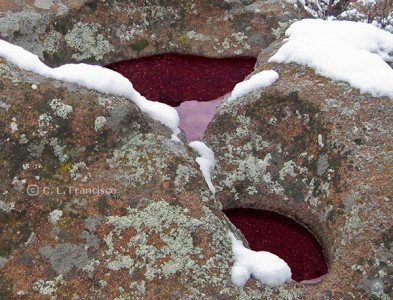
I am unlikely ever to hear a stone speak in human words, or a tree in propositions, or a dog in iambic pentameter. A stone communicates in the manner of stones, just as a dog communicates as dogs do. My experience of the speech of stones is deeply non-verbal, partly visceral and partly emotional, untranslatable. Sometimes I take a photograph or pick up a stone when I feel it; other times I simply let it be. The imagery comes later.
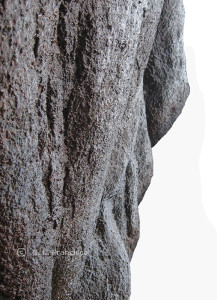
I am not a professional photographer, or even educated in photography. In the past I saw the images in a camera’s eye as an imagined canvas, in terms of shape and balance, tension and flow, light and dark. Now I find myself photographing scenes that pulse with the energy of subtle presence, and I let the rest take care of itself. Sometimes my pictures absorb a hint of that power, sometimes not.
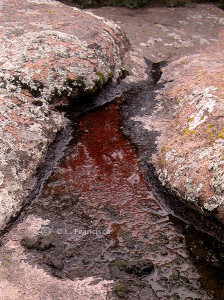
What is a photograph? At its simplest it is a record of objects seen, events observed, people known. But like history, a photograph participates in the awareness of the one who watches and records. And like a scientific experiment, the photographer’s participation is a variable that must be considered. The same scene taken by different people with identical cameras at roughly the same time may be distinctly different—based on something I call “soul,” for lack of any better term. At times the camera’s eye appears to mediate an exchange of understanding? meaning? relationship? being? between photographer and subject, and this fleeting touch (or lack of it) marks the photo.
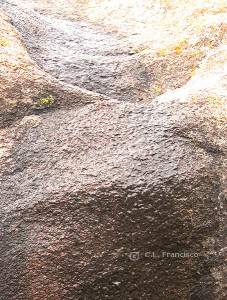
What are the stones saying with their images? I believe they are communicating their presence, no more. “Look at us!” they cry. “We are alive, in ways you have forgotten you ever knew. We are—as the trees are, and the waters, and the atmosphere that shields the Earth from the extremes of space. Truly see us—see all of creation—we who have been dismissed by your arrogance as mere commodities. See us, before only stones remain to see the sunrise.”

Slipping unseen along the fringes of consciousness, the temptation is always there—to “clean up” the images, make them perfect, adjust their proportions to fit more neatly into Western ideas of beauty. Sometimes I make changes without thinking, and then I have to destroy the image if I can’t undo the edits. We have an implicit understanding, the stones and I—that their images will remain as I find them, removed only from their matrix, and, at most, adjusted for contrast. After all, they are the language of stone, and much is inevitably lost in translation.

Many years ago I discovered a new word: panentheism. Not pantheism (many gods), not theism (usually one god separate from creation), but pan-en-theism—one Spirit present in all creation, without the great divide between spirit and flesh that seems unavoidable in most Western traditions. Perhaps this word can suggest a way to bridge the gulf between stones that speak and a planet of dead rock.
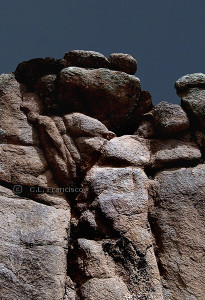
In Christian scripture the apostle Paul describes the perceptions of ordinary people: “For now we see in a mirror, dimly . . . .” These words could describe any human being who has lost her sense of kinship with the web of life in which she lives. We see the world distorted in a bit of poorly polished metal—and ourselves more prominently than all else. But unlike Longfellow’s Lady of Shallot, we have no curse to excuse our stubborn avoidance of the Earth’s true face.
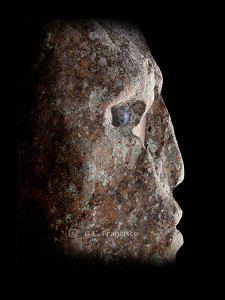
Stone is patient. Stone does not envy or boast, and is neither arrogant nor rude. Stone simply is, demanding nothing. Stone is not false, but embodies the truth of creation. Stone accepts human abuse and awaits our healing. Stone endures all things, is always being transformed, yet is ever the same.

All the photos in The Stones of Easter series* were taken on my brother Don’s mountain during Easter week, 2010, when I was deeply immersed in writing the final chapters of The Gospel According to Yeshua’s Cat. Starting on the morning of Maundy Thursday and ending on Easter Sunday, each day I packed a lunch and water flask and set off up the mountain with my camera. In a very literal sense, I went in search of a vision.

The result of the vision that met me there is Yeshua’s Cat.
And, of course, one of Wendy’s cats.
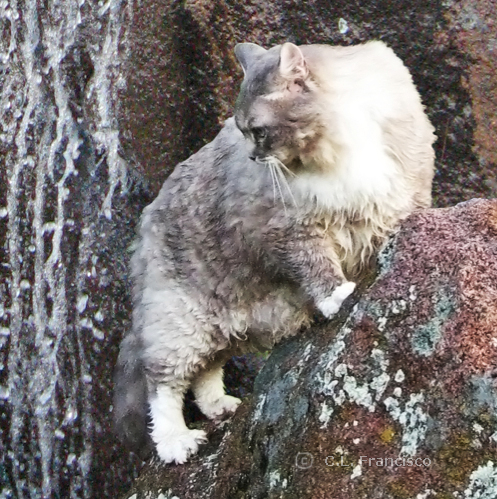
.
* Sixteen photos in The Stones of Easter series are available for sale at http://www.zazzle.com/moon_seasons. The original series included 24.
.
.

.
In the days before Yeshua’s Cat was written, before the wildfire scorched our land, I was exploring the changes that had carried humanity forward in time from the old Earth-based cultures of the Stone Age, through the violent upheavals of the late Bronze Age, and into the time of the Roman Empire. The planned lectures and workshops vanished in the wildfire’s smoke, but something else emerged. I realized that without the art of these ancient peoples we would understand almost nothing about them. So where was the art of the early church? How had my education in early Christian history managed to focus so entirely on words? As a result, I turned to the internet and the local university library and began to search for the visual language of the early Church. (In case you’d like to explore on your own, Picturing the Bible by Jeffrey Spier is a good place to start.)
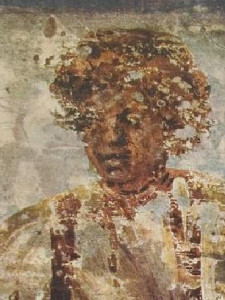
For much of the mid-20th century, common wisdom dismissed the “search for the historical Jesus” as a groundless hope, a fantasy for the unrealistic. But although we may never see a portrait of the flesh and blood man Jesus, the search has proved far from “groundless”: in our time the Earth herself has been yielding up the voices and visions of Jesus’ earliest followers with increasing frequency.
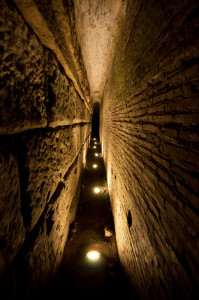
Anyone who visits Rome today steps into a buzzing archaeological hive. This in itself isn’t so strange; after all, many of Rome’s greatest attractions were literally unearthed from its ancient past. What fascinates me is how these ruins emerge. They aren’t turned up by a farmer’s plow, or weathered out of an eroding riverbank, but excavated from beneath the city’s basements. Apparently, Rome buried itself. And the same can be said of Jerusalem, or almost any other Mediterranean capital.* In Rome, for example, the twelfth-century Basilica of San Clemente that still stands today used the walls of the fourth-century San Clemente as foundations. This earlier church rose on top of a first-century mansion. Stairs of ever-increasing age, exposed in recent excavations, descend from the sunlit world down through the virtually intact fourth-century church and into the bowels of ancient Rome. There visitors can walk along a first-century Roman alleyway and explore a now-subterranean apartment building adjacent to the walls of the mansion used as an early Christian meeting place. And under it all lies the rubble of Rome’s great fire of 64 CE.

Canyons carved into the human past are literally opening at our feet along the Roman streets. We can almost believe we hear the slap of sandaled feet two thousand years dead. Anything seems possible. The past walks with us in ways we never imagined. Beneath the many strata of Roman civilization lies tuff, or hardened volcanic ash. Tuff is relatively soft until exposed to air, and is ideal for tunneling. This Roman bedrock made possible the creation of the lowest levels of all Roman ruins, the catacombs. As long as sufficient structural support was left in place, there was almost no limit to the number and extent of these labyrinthine burial chambers.

Although the most famous are Christian, catacombs existed before the early church period, and provided burial space well into the Common Era for those of many different religions. Their painted burial chambers offer us some of the earliest glimpses into the faith of Christian believers, perhaps even back to the middle of the first century.
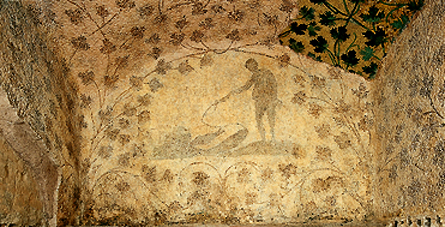
Visual art as a way of communicating our experience of the world is always personal, and far more powerful than words. Art strikes human depths directly. When a person chooses images to express the soul’s deepest yearnings in the face of death, non-essentials fall away. The heart chooses whatever makes life livable, hope possible. When we look at funerary art, we meet human beings as they turn their faces toward the mystery of life moving into death. This mystery is what we find in the catacombs.
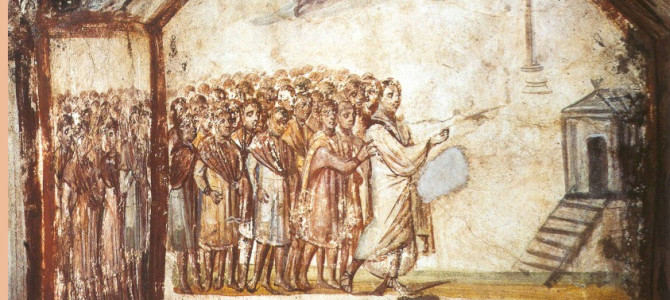
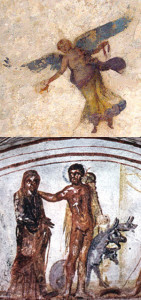
So why are these earliest of Christian testimonies so little known? Why have these painted gospels made so little impact on how Christians understand their faith today? Perhaps it is because our own worldviews get in the way. So an American tourist in Rome snaps a photo of Nike (Winged Victory), and calls her a Christian angel. Another sees a faded catacomb painting of Hercules with the three-headed dog Cerberus and identifies him as the Good Shepherd (with peculiar sheep). We see what we expect to see, squeezing everything into familiar molds. Or perhaps most people just haven’t had the chance yet to truly experience these painted gospels for themselves.
Early Christians chose dramatic images of Jesus and the Old Testament when they painted their tombs. Those appearing most frequently in the 3rd century and earlier are below:.
Jesus the Good Shepherd, who cared unceasingly for his flock:

Jesus the miracle-worker, who healed the sick, raised the dead, and controlled the elements:

Jesus the wise teacher:

Jonah’s sojourn in and emergence from the fish’s belly:
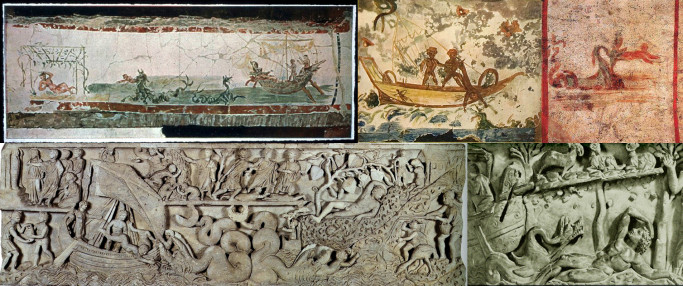
Daniel’s deliverance from the lions:

The three young men protected from the fiery furnace:

Early Christians also painted images of themselves on tomb walls, using two motifs more often than others: women and men with arms raised in prayer and praise; and small groups of Christians gathered around shared ritual meals.

The paintings in the house church at Dura Europos in Syria (dating from about 230-250 CE) are the only Christian images of similar age that have been discovered. The paintings there depict the good shepherd, Jesus’ miracles, the Samaritan woman at the well, and the women at the tomb, as well as Old Testament scenes. Also like the catacombs, they portrayed contemporary believers in positions of praise (orants).
No crucifixes, no suffering martyrs, no images of sacrifice appeared in the early years. These came at least 500 years later, with the developing doctrines of the church.
But what does all this have to do with people like us, living two thousand years later? What impact might it have? Let me paint you a picture with words.
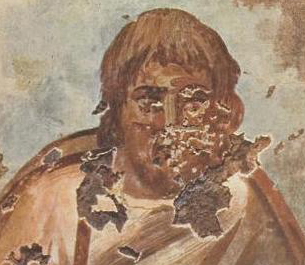
The Christian faith whispering from the dark walls of the catacombs shows us a young man of their own culture–robed, beardless, often holding a wand in his hand–reaching out with compassion and power to touch and heal the human pain around him. He stops the flow of menstrual blood that has made a woman ritually unclean for years. He commands death to release the dead Lazarus, and death yields to him. He sits as a teacher in a circle of disciples, speaking words of life. A strong man with bare legs, he stands among a flock of sheep, carrying a lamb across his shoulders. He betrays no weariness or impatience, only watchful care.
The faith pictured here is in a loving, powerful, and wise man sent from God to point the way and guide his people. They relied on his healing power, his love, and his commitment to their well-being. His God-given power was stronger than death, stronger than the destructive powers of nature, and stronger than human malice.
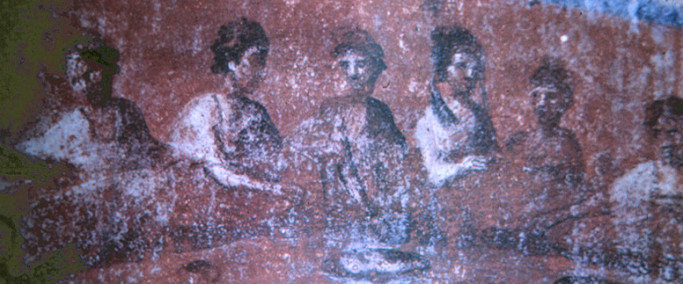
The believers in these painted gospels were neither theologically complex nor concerned with church structure. Women appeared in positions of leadership as often as did men. No canon of scripture had yet been established, although Paul’s letters were circulating among believers by the 50’s–when there were already growing Christian communities in Rome. Church hierarchy was only a spreading shadow on the horizon, and authority was fluid. What we now consider to be the four gospels were written between 70 and 100 CE, and did not become authoritative until much later. Communities of Christians followed their own personal experience and oral traditions, and suffered at the whim of Roman emperors.
By the third and fourth centuries, the increasingly hierarchical church forcibly silenced dissenting voices. Orthodoxy narrowed to a fine line. A few men concentrated all the power in their own hands. Congregations became sheep in ways they had never anticipated in the early years, and their shepherds were not always good. Too often fear, shame, and guilt discouraged the sheep from straying. Bloody sacrifice–Jesus’ own, and that of the martyrs–became a cornerstone of church doctrine where it had never been before. Bishops formulated creeds, damning those who did not confess Jesus in precisely their words–along with all followers of other faiths. The groundwork was laid for the Crusades and the Inquisition.

Like the Romans buried Rome, the church buried itself. But unlike Rome, what the church buried they rarely considered fit to use for new foundations. Whether these developments, and those that have followed in the centuries since, have anything at all to do with the message of Jesus of Nazareth is a question more and more people are asking today. In the end each of us may need to dig through the rubble of time and consciousness to find our own buried treasure. But one thing seems clear: the treasure is there. Perhaps our perceptions are at fault.
.
.
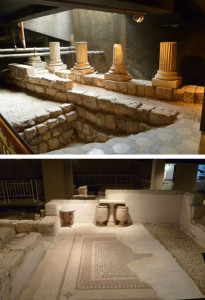
* The Wohl Museum of Archaeology in Jerusalem has excavated similar subterranean houses of the Herodian period from the hillside overlooking the Temple Mount. Although currently the museum has no website of its own, many pictures of their discoveries are available online . . . .
.
.
A number of people have asked me to share more about the wildfire that resulted in the death of the young cat whose memory lies behind Mari in The Gospel According to Yeshua’s Cat. This is the story of that wildfire.
![]()
Killing drought followed years of plentiful rainfall. Temperatures spiked into the 100’s and refused to drop. Creeks ran low. The odor of pine resin hung heavy in the air. A dry lightning strike—and a rancher who didn’t take it seriously enough—provided the critical mass, and two weeks later wildfire had consumed 40,000 acres of forest, pastures, and homes.
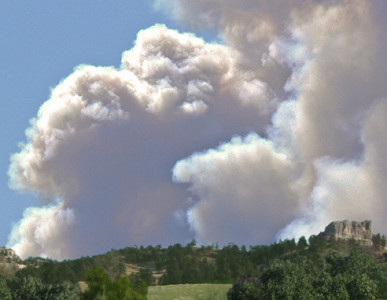 We dismissed the first smoke rising behind the buttes as nothing more than a wayward cloud, never imagining that the storm building there would explode into a holocaust. The days that followed dragged by in anxious succession. Winds dropped, and then blew up again out of nowhere. The fire turned back on itself, only to gather strength and roar off in another direction. Waves of rumor obliterated facts.
We dismissed the first smoke rising behind the buttes as nothing more than a wayward cloud, never imagining that the storm building there would explode into a holocaust. The days that followed dragged by in anxious succession. Winds dropped, and then blew up again out of nowhere. The fire turned back on itself, only to gather strength and roar off in another direction. Waves of rumor obliterated facts.
One night we drove out to watch the fire’s progress from a nearby ridge. News pictures of fire-lit nightscapes are commonplace now, but for us 8 years ago the scene was nothing less than apocalyptic. Small refugee animals fleeing the fire choked the dirt roads as we steered a path among them. I remember the porcupines best, humping their way in unseemly haste through the sullen light. Lines of flame spreading across the black ridges looked like flowing lava. The images presented themselves to our visual processors as nonsense, unreadable data. Nothing in our lives had prepared us for this.

First we evacuated the horses, just in case. We found carriers for the dogs and cats and set them by the doors. When the call came, we were as ready as we could have been, but we had room for little but the animals, basic clothing, toiletries, and our computers. Then for a week of endless days we waited in a small motel on a busy highway 30 miles away.
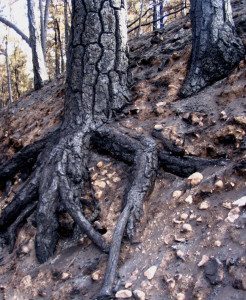 Why our home didn’t burn will always remain a mystery. The firefighters abandoned their efforts in the face of high winds and encircling fire. We were advised to expect a total loss. But in the end, the flames stopped as if by divine fiat all along the wire pasture fences that enclosed our buildings. Sap melted out of the old redwood paneling in my house from the heat, but only the land burned—the land and something deep in the flesh of my small black cat.
Why our home didn’t burn will always remain a mystery. The firefighters abandoned their efforts in the face of high winds and encircling fire. We were advised to expect a total loss. But in the end, the flames stopped as if by divine fiat all along the wire pasture fences that enclosed our buildings. Sap melted out of the old redwood paneling in my house from the heat, but only the land burned—the land and something deep in the flesh of my small black cat.
Morgan, cat of quiet pine groves that she was, probably hadn’t ever been in any building other than my house, and certainly never a motel on a busy highway. For a week she hardly came out from under the bed. No matter what I tried, she refused to eat, and she probably didn’t drink. By the time we returned to the still-smoldering ruins of our forest, she had a urinary infection. No medication touched it, and she grew steadily weaker, until at last the vet tested her for feline leukemia. The results were positive: she’d probably been born with it. All options vanished. The vet’s theory, and a sound one from what I’ve heard, was that the physical stress of her changed environment roused the sleeping disease into burning life. She might have stood a better chance if I’d left her behind to survive the wildfire on her own.
Within two months of the fire, Morgan was dead. I buried her in the charred grove where we had planned to build a small chapel. Beneath boughs once sweet with resin, in smoke-filled light and brittle shade, I laid her under the endless sky. And I grieved.
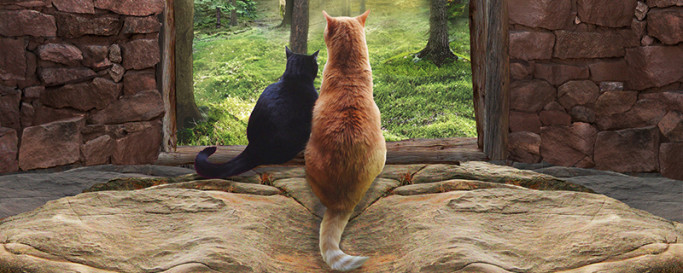
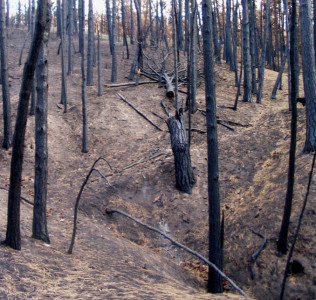 But the grief had really begun when the vet first placed the figurative black cloth on his head and passed sentence of death. A dead forest surrounded me. My gentle cat was fading away in my arms. Eventually I gathered courage and resumed my walks beneath beloved trees, now wasted skeletons streaked with amber tears.
But the grief had really begun when the vet first placed the figurative black cloth on his head and passed sentence of death. A dead forest surrounded me. My gentle cat was fading away in my arms. Eventually I gathered courage and resumed my walks beneath beloved trees, now wasted skeletons streaked with amber tears.
.
I remember shutting my heart against the echoes of pain that surely must lie in ambush along those charcoaled aisles. But as weeks passed, only woodland stillness reigned. Blowing ash darkened the sun—smoke without fire, forest lives airborne—but already the forest’s heart was turning to the east. Life was emerging from death.
Blasted meadows were greening. Tenacious pines, seared but stubborn, drank deep to gather strength for life. Fire-crimsoned cones dropped seed. Seedlings broke the fragile soil. *
I found comfort in the cycle of life, and even in death..
Somehow over the next five years, Morgan’s death, questions about the Creator’s on-going involvement in non-human nature, the timing of Jesus’ coming in human history, and the redemption of the suffering Earth—all came together into the creation of Yeshua’s Cat. The spiritual doubts that had plagued my heart for years ripened and bore sweet fruit.
.
I’ll continue the story of this journey in a few weeks. Come back soon!
.
* To read about the devastating effects of salvage logging on the recovery of burned forests, click here.
.
.
What exactly was the Decapolis? It was mentioned twice in Mark’s gospel and once in Matthew’s, but described only as a region near Galilee where Jesus’ fame spread. In The Gospel According to Yeshua’s Cat, Yeshua and Mari spend considerable time in the Decapolis among the Greco-Roman peoples there.
Decapolis meant literally “ten cities” in Greek, and referred to a loosely knit group of ancient cities in what is now Israel, Jordan, and Syria. No one can say for sure which cities were included in the ten–or even if there were exactly ten–since their relationship was never formalized in Greek or Roman law. As best we know, they were independent cities, each established as a polis, or city-state, with its own local sphere of influence. They supported each other because of their common ties of culture, similar economic interests, and commitment to the Greek, and later, Roman, empires. With the construction of Roman roads they became even more closely interconnected: outposts of the Roman Empire on its furthest eastern edges, islands of Greco-Roman speech and culture, determinedly set apart from the Aramaean, Nabataean, and Jewish populations all around them.

The red dots on the map above mark the eight cities closest to Galilee that were probably included in the Decapolis in the early 1st C. CE. The cities connected by red lines are the ones Yeshua visited in The Gospel According to Yeshua’s Cat, although (except for Scythopolis) they aren’t identified by name in the book. In the paragraphs below, cities where specific events in Yeshua’s Cat took place are identified by small cat silhouettes:
![]()
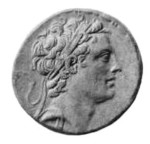
Greek influence in Syria was strongest between the time of Alexander the Great and the reign of the Seleucid emperor Antiochus IV Epiphanes, whose rule ended a century before the Roman conquest in 63 BCE. Most of the Decapolis cities were founded during this period.
When Antiochus Epiphanes desecrated the Temple and forbade the observance of the Jewish religion, Israel revolted, led by Mattathias the
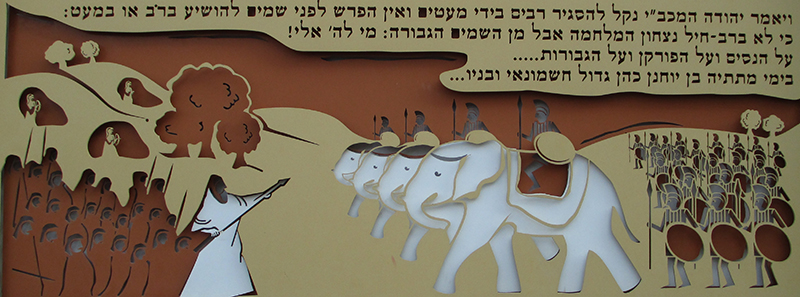
Hasmonean and his five sons, later known as the Maccabees. They overwhelmed the Seleucids and forced them to concede Israel’s limited independence, thus founding the Hasmonaean dynasty, which ruled in Israel until after the Roman conquest. Once the Greeks were defeated in Israel, the Hasmonaeans turned their eyes to the walled cities of Trans-Jordan, and conquered most of the Decapolis by the beginning of the 1st C BCE.
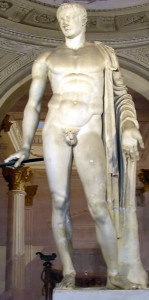
After annexing the Decapolis, the Hasmonaeans forced Judaism and circumcision on the predominantly gentile population of Hippos, exiled the gentiles from Scythopolis, and burned Pella to the ground after it refused to accept the Jewish religion. Circumcision was a point of irreconcilable conflict between Greeks and Jews. For the Jews it was the essential mark of the male believer in the One God; for Greeks it was a desecration of the divinely formed human body.
Hard feelings between the people of Israel and the Decapolis during the time of Jesus had roots both in the Seleucid oppression of Israel and the years of warfare under the Hasmonaeans. Each side had known cruelty and suffering. When Pompey claimed the Decapolis for Rome in 63 BCE, the gentile population greeted him as a liberator, and killed many Jewish residents in revenge for Hasmonaean cruelty. Once the Romans established themselves in the Decapolis, a period of extensive rebuilding began, lasting into the 2nd and 3rd centuries CE. As a result, little remains of the original Greek cities.
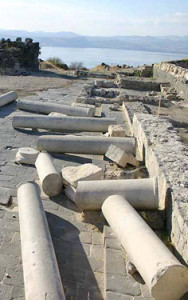
 HIPPOS sat on a high ridge overlooking the eastern side of Sea of Galilee, surrounded on all sides by steep inclines and high fortifications. One thin shoulder of rock approached the main gate on the east, where a fortified road connected the city to the eastern hills as well as indirectly to the sea. Of all the Decapolis cities, Hippos is said to have harbored the greatest antagonism toward Israel for her part in the Hasmonaean wars.
HIPPOS sat on a high ridge overlooking the eastern side of Sea of Galilee, surrounded on all sides by steep inclines and high fortifications. One thin shoulder of rock approached the main gate on the east, where a fortified road connected the city to the eastern hills as well as indirectly to the sea. Of all the Decapolis cities, Hippos is said to have harbored the greatest antagonism toward Israel for her part in the Hasmonaean wars.
![]() As you read of the blind man Yeshua healed outside the gates of the first Decapolis city he visited, you can imagine that long ridge by which travelers still approach the gates of Hippos.
As you read of the blind man Yeshua healed outside the gates of the first Decapolis city he visited, you can imagine that long ridge by which travelers still approach the gates of Hippos.

![]()
 GADARA, like Hippos, was built on a long ridge with steeply sloping sides. Unlike the other Decapolis cities, Gadara developed an international reputation for philosophy, art, and literature. Pilgrims to the hot springs located below the city also contributed to its cosmopolitan atmosphere. Some scholars believe that the story of the demoniac among the tombs was set in its general locale.
GADARA, like Hippos, was built on a long ridge with steeply sloping sides. Unlike the other Decapolis cities, Gadara developed an international reputation for philosophy, art, and literature. Pilgrims to the hot springs located below the city also contributed to its cosmopolitan atmosphere. Some scholars believe that the story of the demoniac among the tombs was set in its general locale.
![]() Yeshua’s debate with the young philosopher took place in a wealthy home in Gadara.
Yeshua’s debate with the young philosopher took place in a wealthy home in Gadara.
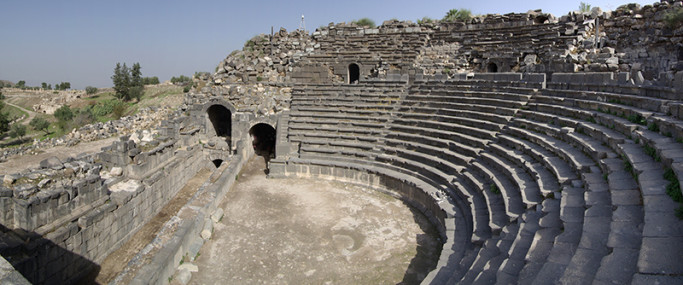
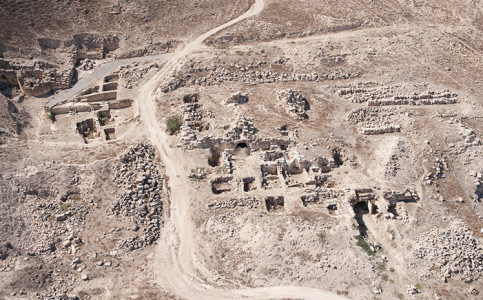
ABILA is still little more than an excavation in process, with only tantalizing possibilities visible to the visitor. But the area awaiting excavation is immense. The ruins extend across two tells, and appear to include structures going back as far as 4000 BCE.
![]()
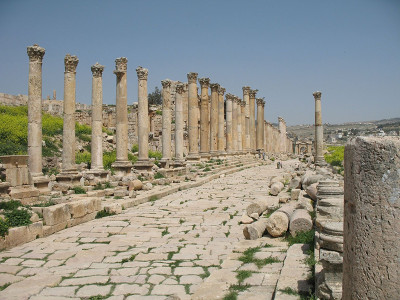
GERASA, or JARASH, was a strong walled city, but stood in a river valley rather than on a hill. Most of the surviving structures date back to a massive Roman building program begun in the 1st C CE. The Cardo, or main thoroughfare, is one of oldest structures, running east-west through the city, with the marketplace on its west side.
Below are the remains of the market, or macellum, where Yeshua’s parable of the prodigal son brought a tide of change to the people of the Decapolis. This was also the market where Mari trapped Maryam into speaking with Yeshua.
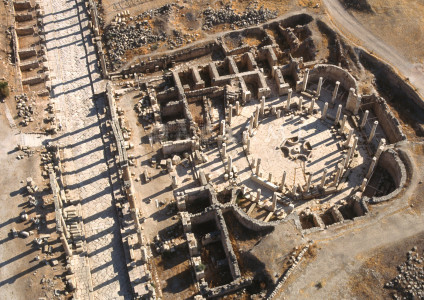
PELLA, of all the ancient cities of the Decapolis, has left the greatest mystery behind. Almost no ruins from the Roman period have survived. Located in the hills on the east side of the Jordan Valley, on a major Roman road, Pella lay in an area with fertile soil and plentiful water, where towns had stood almost continuously from Neolithic times. After Alexander Jannaeus sacked and leveled the city in 82 BCE, it was entirely rebuilt by the Romans. Archaeologists have suggested that after the great earthquake of 526, the inhabitants of Pella might have recycled the rubble of Roman buildings to rebuild the city.

![]() SCYTHOPOLIS, or BEIT SHE’AN, is the only one of the Decapolis cities located on the western side of the Sea of Galilee. These ruins have been extensively excavated, revealing almost continuous occupation from the earliest times, although the city’s significance fluctuated with intermittent wars and violent conquest. The Seleucids founded Scythopolis in the 3rd C BCE on the ruins of the ancient city of Beit She’an, destroyed during the Assyrian sack of Israel. During the Hasmonaean wars much of the Greek polis was destroyed. Once the Romans took over, Scythopolis was named the capital of the Decapolis, and a massive urban building program began, which continued through the next 2-300 years. The steep hill, or tell, which rises to the north of today’s excavated Roman city, covers the remains of the biblical Beit She’an, as well as Seleucid and early Roman ruins. Most of the monumental Roman buildings were completed during the 2nd and 3rd centuries CE on the flat land to the south and east of the tell, leaving little evidence of the city’s appearance during the time of Jesus, although the main layout of the streets may have been similar.
SCYTHOPOLIS, or BEIT SHE’AN, is the only one of the Decapolis cities located on the western side of the Sea of Galilee. These ruins have been extensively excavated, revealing almost continuous occupation from the earliest times, although the city’s significance fluctuated with intermittent wars and violent conquest. The Seleucids founded Scythopolis in the 3rd C BCE on the ruins of the ancient city of Beit She’an, destroyed during the Assyrian sack of Israel. During the Hasmonaean wars much of the Greek polis was destroyed. Once the Romans took over, Scythopolis was named the capital of the Decapolis, and a massive urban building program began, which continued through the next 2-300 years. The steep hill, or tell, which rises to the north of today’s excavated Roman city, covers the remains of the biblical Beit She’an, as well as Seleucid and early Roman ruins. Most of the monumental Roman buildings were completed during the 2nd and 3rd centuries CE on the flat land to the south and east of the tell, leaving little evidence of the city’s appearance during the time of Jesus, although the main layout of the streets may have been similar.

Temples were built on the tell at various times during Greek and Roman occupation, perhaps partly because of Scythopolis’ fame as a major center for the worship of Dionysos. Legends of the time located the tomb of his nurse Nysa at Scythopolis.
![]() Because of the city’s connection to the Greco-Roman dying and rising agricultural god, in Yeshua’s Cat the procession of Tammuz’ devotees witnessed by Mari, Yeshua, and the disciples took place in Scythopolis. The tell was the hill the mourning women climbed by torchlight.
Because of the city’s connection to the Greco-Roman dying and rising agricultural god, in Yeshua’s Cat the procession of Tammuz’ devotees witnessed by Mari, Yeshua, and the disciples took place in Scythopolis. The tell was the hill the mourning women climbed by torchlight.

.
.
My sister-in-law Wendy Francisco (who did the art for Yeshua’s Cat’s front cover) has insisted that I would find myself adding new pages to the Cat from time to time, and I have equally firmly replied that I never would. Well, Wendy won. Over the last two or three weeks that unmistakable nudge (much like a cat butting her head against your chest) has been growing more insistent.
And, Donna West, it was your kind comment on my post about the cat who inspired the book that pushed the nudge into actual words, drawing me out of the busy-ness of publishing concerns and back into Mari’s world.
So, I wish each of you a blessed Christmas, and as a gift from Mari to you, here are a few new words from her, never published before–perhaps for some later edition.
For those of you who have the paperback edition, this would be inserted at the top of page 124, just after “. . . filled with laughter.” For those of you with the Kindle edition, it’s in Chapter 15, Magdala, just after Mari muses about the nature of the festival of lights, and before Yeshua starts speaking on the last night of the feast.
* * *

One night after everyone had gone to bed I finally asked him. “Are your people celebrating the return of the sun’s warmth when they celebrate their festival of lights, son of Earth?”
“Yes and no, little mother,” he replied, turning his head and smiling as he opened his eyes. “We measure the years by the seasons of the moon, not by the sun’s path, so none of our holy days takes note of the sun’s movement, not even this one. No, this week we rejoice in events almost 200 years past, when a great man named Judas Maccabeus cleansed the Temple in Jerusalem from the pollution of a pagan altar put there by foreign conquerors. Our many lamps call us to remember that the One’s light can dispel even the deepest darkness.”
He rose to his feet and reached out his arm in invitation, so I leapt to his shoulder, wrapping my tail around his neck. Together we walked out under the winter sky and stood on the hill, watching the stars touch the great sea with their cold fire.
“Yet, little leopard,” he continued as if he had never paused, “you are right when you wonder if we are also welcoming the sun’s return. Just as stars grow brighter in the long nights, each light that burns in winter’s darkness whispers of that hope. Together with all Earth’s children, our hearts grow full when we see the sun begin its long journey back to the heights of heaven. This too reminds us of the One’s faithfulness.”
I curled around his neck more closely to dispel the night’s chill, but I said nothing. I only purred with pleasure at his closeness. I sensed that words still lay unspoken in his heart.
“Sweet Mari, my mother told me that I was born on a night like this, when the stars danced in a black sky, and the breath of humans and beasts alike clouded vision with their brief mist. Joy filled the night and sang in the heavens at the wonder of my coming into the world. All things were made new under that sky, she said.”
I rubbed my whiskers against his cheek, and he continued.
“I can almost hear the heavens singing on such nights. The One’s face shimmers behind the host of stars like a distant oasis in the heat of a desert’s summer day. And yet the chill of a winter night and the searing heat of the desert’s noon both lie quiet in the hollow of his hand.
“As do you and I.”
.
.
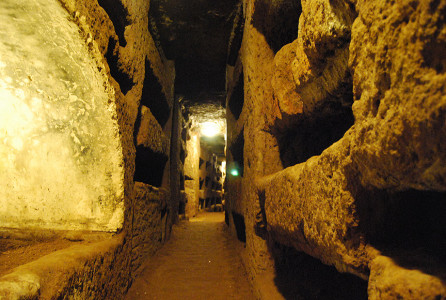
Did you know that most of the very early “Christmas” art that has survived into the present is in the catacombs around Rome?

Perhaps the earliest known Christian painting is a simple 2nd century portrayal of the Annunciation, on the dome of a tomb in the Catacomb of Priscilla. But dating wall paintings is an inexact science at times, and many believe the paintings at Dura Europos to be earlier.
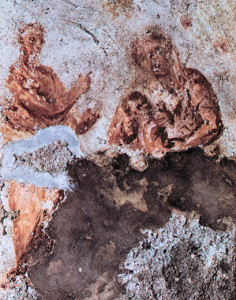
A painting of the Madonna and Child in the same catacomb complex has been dated to the late 3rd century. These paintings were done in the popular Roman style of the time.
Much of what remains of early Christian art has been discovered in these catacombs, which were used primarily from the 2nd through the 8th centuries CE. They were closed in the 9th century, mainly because of repetitive destruction by invading Goths and Lombards.
Crosses were not common among the earliest symbols. Instead, the Chi Rho, Good Shepherd, fish, anchors, alpha and omega, and praying figures known as “orants” were typically used to decorate tombs. The Good Shepherd in particular was also a common symbol for pagan Roman burials.
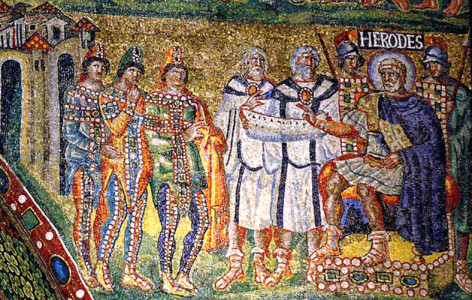
Not until after 313, when the Edict of Milan made the practice of Christianity legal throughout the Roman Empire, did Christian art become more public, and eventually, more complex. The Magi with their gifts was a favorite theme in the 4th and 5th centuries, as was the Annunciation, the angels singing praises, and the Virgin and Child; however, Mary was most often portrayed solemnly, seated on a throne with the child in her lap.
There has been some discussion about whether the arrow-like symbols in the painting below of Jesus with Peter and Paul might also be angels.
After the first millennium artists began to “humanize” the nativity, adding details to the scene and softening Mary’s appearance. Finally, by the 1300’s the classical paintings we’re familiar with today began to emerge.
Interestingly enough, the first portrayal of Jesus on the cross didn’t appear until sometime between the 6th and 8th centuries.
.
.

Thanksgiving’s closest parallel in Israel’s year is the Festival of Sukkot, or Booths/Tabernacles, one of the three great Jerusalem pilgrimage festivals. Because of Israel’s lunar calendar, Sukkot, like Passover, falls on different days and even different months each year in our solar calendar, but generally it comes in mid-October.
In the story of Yeshua’s Cat, Sukkot is the time Yeshua and his disciples spend at Bethany, when Lazarus attacks Mari, and Mary of Magdala is healed.
![]()

Sukkot has its roots in Israel’s celebration of the harvest, when they gathered in the fruit of their labors from the fields and vineyards, and celebrated the beginning of the rainy season.
 Throughout the week, four species of plants were ceremonially waved (citron fruit, the closed frond of a date palm, and leafy boughs of the myrtle and willow trees) in recognition of the green trees of the land. Wheat, barley, grapes, figs, pomegranates, olives, and dates represented their harvested crops. Above all, the week was a time of rejoicing, and of remembering God’s care for Israel during the years of her wandering in the wilderness and living in tents, or booths.
Throughout the week, four species of plants were ceremonially waved (citron fruit, the closed frond of a date palm, and leafy boughs of the myrtle and willow trees) in recognition of the green trees of the land. Wheat, barley, grapes, figs, pomegranates, olives, and dates represented their harvested crops. Above all, the week was a time of rejoicing, and of remembering God’s care for Israel during the years of her wandering in the wilderness and living in tents, or booths.
 Before the first and holiest day of Sukkot, which came five days after Yom Kippur, each family built a small booth, where they lived together during the festival.
Before the first and holiest day of Sukkot, which came five days after Yom Kippur, each family built a small booth, where they lived together during the festival.
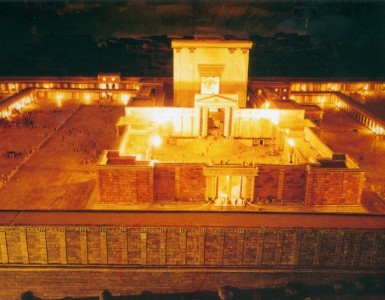
On the day itself, sacrifices of animals and grain began and continued throughout the week. The Illumination of the Temple came at the end of the first day, when four seventy-five-foot candelabras were lit in the Women’s Court of the Temple to remind the people of the pillar of fire that had guided them in the wilderness. Dancing and rejoicing continued through that night, and the whole city was lit by the brilliance of the lamps.
The Pouring of the Water was observed each morning when a priest drew water from the pool of Siloam and poured it on the great altar, as both prayer and thanks for the coming of the rains. Each evening the devout men of Israel gathered at the pool to dance and rejoice with music and torches.
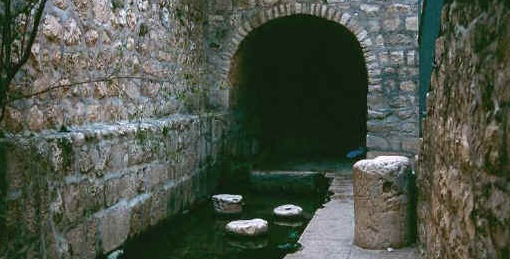
Not only did Sukkot celebrate the gathering in of the crops before the heavy rains and the memory of Israel’s wilderness journey, but also the beginning of the New Year, when the past year’s mistakes had been wiped away, and all the world was new.
.
.
.
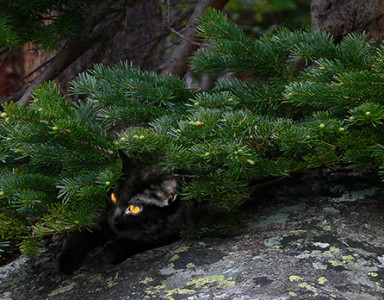
How did the cat in Yeshua’s Cat come to be?
I’d like to say that Mari emerged fully grown from my brow, like Athena from the brow of Zeus, but it didn’t happen that way. She grew slowly as I wrote, born from the personality of the small black cat under the fir tree in the photo, maturing and growing as the book grew, and I with it. She was the author of the book as much as I.

While I was writing Yeshua’s Cat, I was also lending a hand with my sister-in-law Wendy’s Ragdoll cattery. So not only did I have my three rescue cats dancing in and out of my thoughts and over my computer keys, but I also entertained rolling tides of soft-furred queens, kings, princes and princesses, rising and tumbling over the threshold of my room with the rhythms of the day. (They’re gorgeous, by the way: Treasure Mountain Ragdolls).
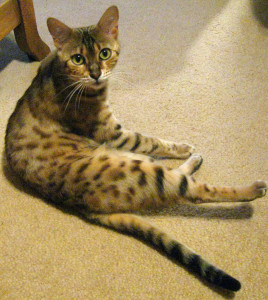
And then there was Chami, the elegant Bengal queen who moved in with me for several weeks while she was between homes. Beautiful and sweet-tempered though she was, she left me feeling as if living with her was a bit like inviting a panther into my bed. I slept lightly in her presence. I suppose the movie Cat Woman deserves mention as well, disappointing as it was. It did send me googling off for more data on the Egyptian Mau. Before seeing the movie, I knew little more than rumors of the breed. Afterwards I was curious enough to want to discover how much of the movie’s hype had been based in fact.

What conclusions I drew about the relationships between the movie and the Mau I no longer remember, but I did stumble onto one amazing thing: the Egyptian Mau cats in the photos looked like the Mari in my mind. I had finished the book by the time I made this discovery, but that made no difference to the identification. Mari was darker than most Egyptian Mau, more like a black or smoke Mau, but her build, her markings, and her face were all theirs–not to mention her affectionate nature, her devotion to her human, her protectiveness, and her hunting skills. So her breed was established, at least in my mind.
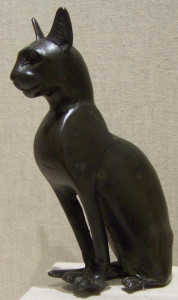
Since Yeshua discovered Mari on the edges of the barren desert surrounding the Dead Sea, I decided that her feline family might have arrived in the area by way of the Nabataean caravans traveling up from Sinai. Or perhaps they were wandering strays from one of the Nabataean cities to the south, or even escapees from a passing camel train. The Nabataeans had originally been tent-dwelling desert shepherds and traders, a mysterious group related to the Bedouin who amassed great wealth over several centuries from their trading networks, and eventually settled down in desert cities. Rock-cut Petra is their most famous settlement, although they also built cities further west and south along the ancient spice routes.
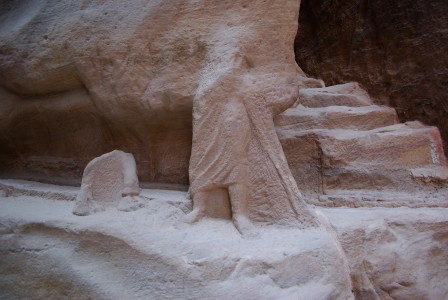

As far as research can tell us, people of 1st C Israel did not keep pets–even dogs–although there was some limited cooperation between the two species. Perhaps the absence of pets was due to Israel’s concern for ritual purity, particularly relating to the ritual uncleanness of scavengers and predators. In any case, their attitude toward animals seemed largely functional. The prophet Ezekiel singled out Bubastis, city of the temple of the cat goddess Bastet, as one of the cities upon which God would pour out his wrath (Ezek 30:17). His mention of this city suggests that the cat goddess was familiar to the people of Israel. She might even have inspired dislike of cats in general. Wealthy Greeks and Romans, however, frequently kept pets, ranging from snakes, monkeys, and fowl to their favorite pet, the dog. But outside of Egypt cats weren’t often accepted as companions until the Common Era.
Cats almost certainly lived on the fringes of Israelite society, even though they may not have been welcomed into people’s homes. By the 1st C C.E., cats had been semi-domesticated throughout the eastern Mediterranean area for several thousand years. Wherever grain was cultivated, rodent control was essential, and cats filled that ecological niche efficiently. They would have been a long-established part of Israel’s environment.
![]()
For Yeshua to have kept company with a cat would certainly have been seen as aberrant behavior, even religiously questionable. But he had his own ways of dealing with such things.
.
.